
The Hall Art Foundation is pleased to announce an exhibition by famed American artist Andy Warhol to be held in its galleries in Reading, Vermont from 13 May – 26 November 2023. Cultural icon, celebrity and provocateur, Andy Warhol produced works that are instantly recognizable and have inspired a generation of artists. Seriality and appropriation were signature aspects of Warhol’s painting and sculptural practice. He often made many different versions of the same subject, perhaps most famously with his iconic multi-part work, Campbell’s Soup Cans (1962) which depicts 32 different versions of a Campbell’s soup can. Shortly after completing these works, Warhol began to make paintings using silk-screens, a process that greatly facilitated his explorations of image multiplicity. For any given subject, Warhol might use several different source images, producing multiple versions of each picture, sometimes in different sized formats, or sometimes using different color combinations for the silkscreen inks and paints, or sometimes both. In other cases, he would use the same exact silkscreen and the same color silkscreen inks and paints, allowing the randomness of the screening process itself to introduce variations in tonality and color saturation in the individual paintings.
Warhol was a painter, photographer, draftsman, sculptor, filmmaker, collector and diarist, but this show focuses on just his paintings. And while Warhol made many large-scale paintings, this is an exhibition of some 100 smaller format, domestically scaled works, all from the Hall Collection, that span his entire career as a fine artist, with important examples from his most seminal series, and which provide a more intimate look at Warhol. The largest work presented here is Twenty Fuchsia Maos (1979), which measures 39 x 38 inches and portrays an iconic reversal (or negative) image of Chairman Mao Zedong repeated 20 times. The smallest work is Roy Lichtenstein (1967), a portrait of Warhol’s Pop Art contemporary which measures just 5 ½ x 4 inches. Altogether, the 100 works presented in “Small is Beautiful” provide a comprehensive retrospective of the paintings of Andy Warhol, but in small scale.
After moving to New York from Pittsburgh in 1949, Warhol began his career as a commercial illustrator. Although by the 1950s he had become highly successful, his great ambition was to be recognized as a fine artist. Post war America was a place of consumerism and consumption, and print and television advertising saturated the lives of the burgeoning middle class. Warhol and his Pop Art contemporaries sought to celebrate the everyday and the mass produced. Their work was also a means of exploring this new age of consumption.
Campbell's Soup Can (1961) is an early example from a signature series in Warhol’s career, and is now one of the most iconic and recognizable symbols of Pop Art. By using the image of a highly recognizable and commonly available commercial good as his subject, Warhol broke down traditional distinctions between fine art and popular culture. The early example on view is based on an illustrated image of a Campbell’s soup can that Warhol found in a magazine ad. Warhol projected the image of the can onto his canvas and traced its shape. Drawn in pencil and hand-painted with casein, Campbell's Soup Can (1961) illuminates Warhol’s process of breaking-down the image of his appropriated subject. Warhol would soon develop a more mechanized means of making his soup can paintings with a silkscreen process, further developing his strategy of serial repetition.
Warhol began playing with the effect of multiple versions of the same image early in his career. By 1964 and now working in his “silver factory”, Warhol’s silk-screening process and “assembly-line” means of making paintings and sculpture was well established. Warhol’s Flowers (1964-78) – fifteen of which are on view in varying sizes – each display the same four-flower image screen-printed onto linen. Warhol’s Flowers are based on a photograph of seven hibiscus flowers found in a magazine. Warhol appropriated the original photo – cropping it into a square format, amplifying the contrast, and manipulating the composition so only four flowers were left. Other than their size, the works are distinguished by their hand-painted colored backgrounds, and individualized traces of the silkscreen process. Repetition, seriality and pattern would persist as fundamental elements throughout Warhol’s career and can be seen in this show in his portraits, Shadow Paintings, Oxidations, and Positive/Negative works.
Warhol was fascinated by celebrity and Hollywood. He believed that celebrities were as much of a consumer commodity as soup cans or Brillo boxes. In the early 1960s, he began making series of silk-screened portraits of patrons, friends, celebrities, as well as of himself. Portraiture (including in photography and film) would continue to be a key subject for Warhol through the 1980s with examples included here of the artist Joseph Beuys, Chairman Mao Zedong, as well as a late self-portrait of Warhol wearing his famous spiky “fright wig”. Warhol’s self-image – in his own work and in his public persona – pervades his career and is book ended in this exhibition with Self-portrait (1967) and Self-Portrait (Fright Wig) (1986). Creating “Andy Warhol” as an image, icon, and brand was in some ways Warhol’s ultimate work of art.
Hall Art Foundation
544 VT Route 106
Reading, VT 05062
United States
For more information and images, please contact the Foundation’s administrative office at info@hallartfoundation.org.
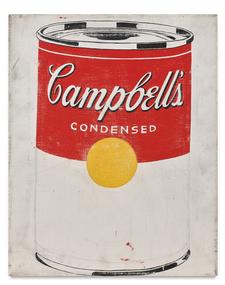
Andy Warhol
Campbell's Soup Can, 1961
Casein and pencil on canvas
20 x 16 in. (51 x 40.5 cm)
Hall Collection. Courtesy Hall Art Foundation.
© 2023 The Andy Warhol Foundation for the Visual Arts, Inc. / Licensed by Artists Rights Society (ARS), New York
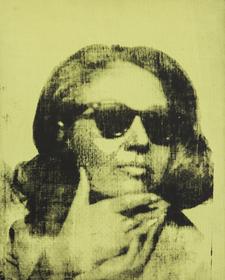
Andy Warhol
Ethel Scull, 1963
Silkscreen ink and acrylic on linen
20 x 16 in. (51 x 40.5 cm)
Hall Collection. Courtesy Hall Art Foundation.
© 2023 The Andy Warhol Foundation for the Visual Arts, Inc. / Licensed by Artists Rights Society (ARS), New York
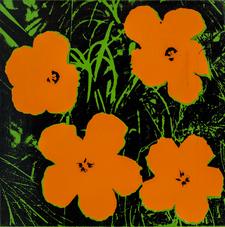
Andy Warhol
Flowers, 1964
Acrylic and silkscreen ink on linen
14 x 14 in. (36 x 36 cm)
Hall Collection. Courtesy Hall Art Foundation.
© 2023 The Andy Warhol Foundation for the Visual Arts, Inc. / Licensed by Artists Rights Society (ARS), New York
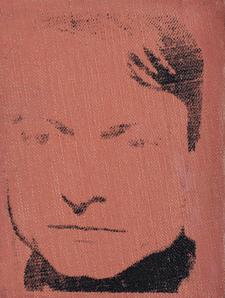
Andy Warhol
Roy Lichtenstein, 1967
Acrylic and silkscreened ink on canvas
5-1/2 x 4 in. (14 x 10.5 cm)
Hall Collection. Courtesy Hall Art Foundation.
© 2023 The Andy Warhol Foundation for the Visual Arts, Inc. / Licensed by Artists Rights Society (ARS), New York
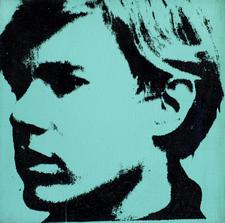
Andy Warhol
Self-portrait, 1967
Acrylic and silkscreen inks on linen
8 x 8 in. (20.3 x 20.3 cm)
Hall Collection. Courtesy Hall Art Foundation.
© 2023 The Andy Warhol Foundation for the Visual Arts, Inc. / Licensed by Artists Rights Society (ARS), New York
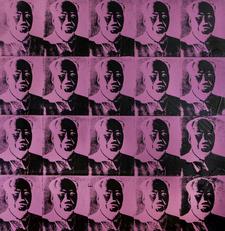
And Warhol,
Twenty Fuchsia Maos, 1979
Synthetic polymer and silkscreen inks on canvas
39-1/2 x 38 in. (100 x 96.5 cm)
Hall Collection. Courtesy Hall Art Foundation.
© 2023 The Andy Warhol Foundation for the Visual Arts, Inc. / Licensed by Artists Rights Society (ARS), New York
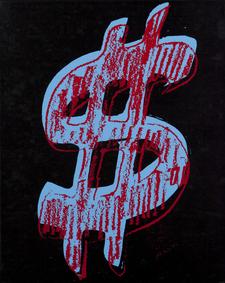
Andy Warhol
Dollar Sign, 1981
Synthetic polymer paint and silkscreen ink on canvas
20 x 16 in. (51 x 40.5 cm)
Hall Collection. Courtesy Hall Art Foundation.
© 2023 The Andy Warhol Foundation for the Visual Arts, Inc. / Licensed by Artists Rights Society (ARS), New York
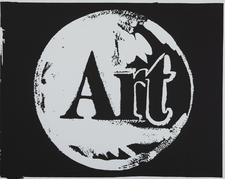
Andy Warhol
Art (negative), 1985-86
Synthetic polymer paint and silkscreen ink on canvas
16 x 20 in. (40.5 x 51 cm)
Hall Collection. Courtesy Hall Art Foundation.
© 2023 The Andy Warhol Foundation for the Visual Arts, Inc. / Licensed by Artists Rights Society (ARS), New York
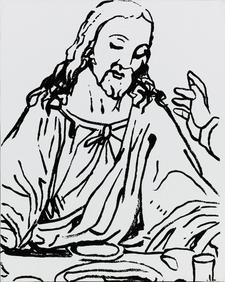
Andy Warhol
Detail of the Last Supper, 1986
Synthetic polymer paint and silkscreen ink on canvas
20 x 16 in. (51 x 40.5 cm)
Hall Collection. Courtesy Hall Art Foundation.
© 2023 The Andy Warhol Foundation for the Visual Arts, Inc. / Licensed by Artists Rights Society (ARS), New York
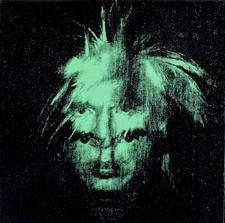
Andy Warhol
Self-Portrait (Fright Wig), 1986
Synthetic polymer paint and silkscreen ink on canvas
10 x 10 in. (25 x 25 cm)
Hall Collection. Courtesy Hall Art Foundation.
© 2023 The Andy Warhol Foundation for the Visual Arts, Inc. / Licensed by Artists Rights Society (ARS), New York